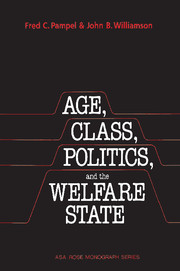Book contents
- Frontmatter
- Contents
- List of tables
- Preface
- 1 The welfare state: some neglected considerations
- 2 Theoretical perspectives on the welfare state
- 3 Social welfare spending in advanced industrial democracies
- 4 Social welfare spending and democratic political context
- 5 Economic growth, social welfare spending, and income inequality
- 6 Infant mortality, equality, and social welfare spending
- 7 Conclusions: The causes and consequences of the welfare state
- References
- Index
- Other books in the series
7 - Conclusions: The causes and consequences of the welfare state
Published online by Cambridge University Press: 30 April 2010
- Frontmatter
- Contents
- List of tables
- Preface
- 1 The welfare state: some neglected considerations
- 2 Theoretical perspectives on the welfare state
- 3 Social welfare spending in advanced industrial democracies
- 4 Social welfare spending and democratic political context
- 5 Economic growth, social welfare spending, and income inequality
- 6 Infant mortality, equality, and social welfare spending
- 7 Conclusions: The causes and consequences of the welfare state
- References
- Index
- Other books in the series
Summary
As is true of any detailed, thorough empirical study, our results are complex and general conclusions must be qualified. Yet, the diverse empirical results in our study lend considerable support to our claim that age structure, politics, and development should be taken more seriously in the study of welfare spending and social equality. With the perspective of the empirical analyses behind us, and a roughly defined interest group theory to make sense of the results, we can review these arguments and the evidence in favor of them.
The aged and the welfare state
The major influence on the rise of social welfare spending from 1950 to 1980, at least in political democracies, is age structure – primarily the rise of the aged population but secondarily the decline in the population of young children. This influence stems in part from automatic entitlements for the increasingly larger number of eligible aged persons. As the major program designed specifically for the aged, pensions respond in part to the sheer growth in the number of persons entitled to benefits. Direct demographic forces likewise prove important for medical care spending. The high rates of illness and medical care usage among older persons, and the expensive and difficult care needed for the very old, mean that the aged receive medical care benefits in excess of their representation in the population. Not surprisingly, then, those societies with the most developed welfare states have the world's oldest populations as well.
- Type
- Chapter
- Information
- Age, Class, Politics, and the Welfare State , pp. 165 - 180Publisher: Cambridge University PressPrint publication year: 1989



